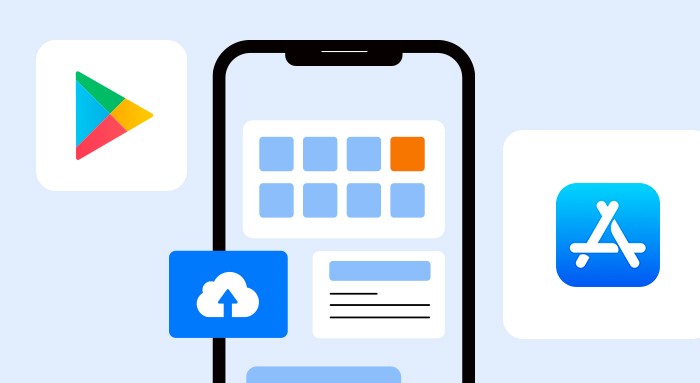Mar 6, 2024
How to make your mobile app's app store listing perform well?
All of your marketing expenses are wasted on a product page that is not optimized. In addition, a well-optimized listing—also referred to as a product page—can have a big impact on the exposure, success, and conversion rates of your game. Consequently, you must develop a strong app store listing if you want to make sure the bottom of your acquisition funnel is optimized.
What is a listing in the app store?
The display of a mobile application or game on an app store platform—like the Google Play Store, Huawei AppGallery, Apple App Store, etc.—is referred to as an app store listing. Potential users can find out about your mobile app on its product page, research it, and then determine whether or not to download it to their mobile devices.
Typically, an app store listing consists of the following components:
A tiny picture that symbolizes the program is called the app icon. When an app is installed, this is the first image that customers see in search results, on the product page, or on their device's home screen.
The name of the app, often known as the title, should be brief and convey its meaning or substance.
A written synopsis of the features, capabilities, and advantages of the app is provided in the app description. It gives customers details about the functionality of the program and the reasons they ought to download it.
Videos and screenshots are types of visual media that highlight an application's main features, gameplay, and user interface. Examples of these are gameplay videos and screenshots.
User-generated ratings and reviews offer comments on the app's functionality and quality as well as social proof.
The app's size, compatibility with various devices and operating systems, version number, release date, and developer information are among the other details.
Changes contain details about new features that have been added to the program, problem patches, and recent changes.
For app marketers, app store listings are an essential marketing and promotional tool. They are explaining to prospective customers the benefits and features of their apps.
Structure for developing a successful app store listing
It takes more than just filling out elements like app title, description, and uploading screenshots to optimize and improve your app store listing's performance. A high-performing product page can be created using the following steps as a framework:
Market analysis
Optimizing App Store Search
Optimization of App Store Conversion Rate
Scale, Analysis, and Optimization
Prior to optimizing your app store placement, conduct market research.
For your app store listing to convert, you must have a thorough understanding of your target market and demographic. It assists in determining your app's market position internationally and enables you to communicate with game players in their native tongue, using their tones and expressions. Consequently, conducting further market research will make your software stand out.
More precisely, you should focus your efforts at this point in the framework on the following points:
Identify your app market position across countries. Look at the app download numbers of your app competitors in different countries. It will help you to discover emerging players and competitive threats.
Examine category rankings to identify patterns in the games. You may compare your app's rating in your primary categories with that of your competitors with App Radar's Category rating function.
Analyze competitors' app store images and metadata to uncover their ASO and ad strategies. By adding applications to your competitor list, you may receive an overview of your competitors' store listing data in a single dashboard, eliminating the need for you to individually review each one of them. Don't forget to review listings from various locals.
Recall that the primary objective is to recognize and incorporate winning patterns into your app marketing plan.
Determine your app's market status internationally. Examine the number of downloads your competitors' apps have received in various nations. It will assist you in identifying up-and-coming competitors and dangers to the market. Examine category rankings to identify patterns in the games. You may compare your app's rating in your primary categories with that of your competitors with App Radar's Category rating function.
Analyze competitors' app store images and metadata to uncover their ASO and ad strategies. By adding applications to your competitor list, you may receive an overview of your competitors' store listing data in a single dashboard, eliminating the need for you to individually review each one of them. Don't forget to review listings from various locals.
Make your app store listing more keyword-relevant.
Use pertinent keywords on your store listing as the following step. Including keywords in the metadata of your app will increase the likelihood that mobile consumers will find it.
Creating a term backlog for your game genre is a good place to start. Make sure the focus keywords you choose have a respectable amount of searches. Additionally, your keywords should accurately convey the genre and concept of your game.
Implement target keywords in your store listing with your next metadata update after you've cleared out your backlog of keywords. Keep in mind that app store algorithms take time to recognize your updates. As a result, avoid updating metadata too frequently and don't anticipate results right away. Aim for a metadata update for your store listing every four weeks.
Optimize your app store conversion rate,
Let your app's functionality be seen in the screenshots. Display your in-app panels and draw attention to the key attributes and advantages for the user.
Include the primary features in the first three to four screenshots. Most users will glance at the initial screens and probably navigate through the remaining ones. Consider your main points carefully, and begin with the one that will have the biggest impact.
The screenshots must tell a story or direct users through tasks. An app concerning automobile sharing ought to provide users with information about what occurs prior to, during, and following a ride-sharing session.
Consider a variety of target markets. Which user groups, markets, or languages would you like to concentrate on? You must localize your software if you want to take it worldwide.



